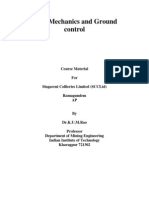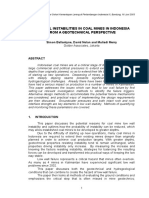Characteristic of Cracks in Tight Sandstone Reservoir: Ming Yan Yunfeng Zhang Jie Gao Ji Gao
Characteristic of Cracks in Tight Sandstone Reservoir: Ming Yan Yunfeng Zhang Jie Gao Ji Gao
Copyright:
Available Formats
Characteristic of Cracks in Tight Sandstone Reservoir: Ming Yan Yunfeng Zhang Jie Gao Ji Gao
Characteristic of Cracks in Tight Sandstone Reservoir: Ming Yan Yunfeng Zhang Jie Gao Ji Gao
Original Description:
Original Title
Copyright
Available Formats
Share this document
Did you find this document useful?
Is this content inappropriate?
Copyright:
Available Formats
Characteristic of Cracks in Tight Sandstone Reservoir: Ming Yan Yunfeng Zhang Jie Gao Ji Gao
Characteristic of Cracks in Tight Sandstone Reservoir: Ming Yan Yunfeng Zhang Jie Gao Ji Gao
Copyright:
Available Formats
IOSR Journal of Engineering (IOSRJEN)
ISSN (e): 2250-3021, ISSN (p): 2278-8719
Vol. 05, Issue 07 (July. 2015), ||V3|| PP 10-13
www.iosrjen.org
Characteristic of Cracks in Tight Sandstone Reservoir
Ming Yan1Yunfeng Zhang1Jie Gao2Ji Gao3
1
(College of Earth Sciences, Northeast Petroleum University, Daqing, Heilongjiang 163318, China)
(Logging and Testing Services Company of Daqing Oilfield, Daqing, Heilongjiang 163414, China)
3
(Electrical Information Engineering Institute, Northeast Petroleum University, Daqing, Heilongjiang 163318,
China)
2
Abstract: - Cracks not only can be used as a good reservoir space, but also is the important reservoir seepage
channel. Study area mainly has tectonic cracks, bedding cracks and diagenesis cracks. Tectonic crack is usually
characterized by irregular serrated, wear layer and oblique development. Bedding cracks grow between two
layers which have different lithology. Diagenesis cracks are controlled by diagenetic process, and it is usually
micro cracks. Tectonic stress controlled the cracks plane and vertical distribution. Sedimentation determines the
original composition and structure of the reservoir rock. Different sedimentary microfacies have different cracks
development degree. Pressure cracks formed by the real pressure. Dissolution cracks formed by the dissolution.
Keywords: - Cracks; Tight sandstone reservoir; Controlling factors; Characteristic
I.
INTRODUCTION
Cracks not only can be used as a good reservoir space, but also is the important reservoir seepage
channel. With the change of the structure of the world oil and gas resources, and the further research of
unconventional oil and gas, micro cracks in the reservoir achieve more attention of many scholars. Through the
cores, thin sections, X-ray diffraction analysis, ZangShibin analyzed micro cracks reservoir in the south oilfield
of Chaidamu basin, and put forward the concept of effective pore throat radius to describe reservoir pore
structure characteristics [1]. HaoMingqiang believes micro cracks low permeability reservoir is mainly provided
by the micro crack seepage ability [2]. NanJunxiang point out the micro crack on the matrix cracks connected is
of great significance, which is one of the productive factors of crude oil [3]. Therefore, the micro cracks reservoir
development characteristics and main control factors research is of great significance for dense reservoir
exploration and development.
II.
THE GENERAL SITUATION IN THE STUDY AREA
Daan oilfield is located in the southern songliao basin in the central depression in the secondary structural belt.
Study area located between the central depression area and west slope area. It is the transition zone of two
relative elevation and subsidence movement. It belongs to the terrace extrusion structure oil and gas
accumulation zone. According to the composition, particle size, the division of property, different standards
have different results.
Fig.1 Rock composition in the study area
Fig.2 Lithology distribution in the study area
From the composition, the study area reservoir rocks are feldspar lithic sandstone and lithic feldspar
sandstone (Fig.1). From the granularity, purpose layer in the study area mainly fine sandstone and siltstone, with
part of argillaceous siltstone and sandstone (Fig.2).From the physical properties, mainly belong to low - low density, ultra-low reservoir (Tab.1).
International organization of Scientific Research
10 | P a g e
Characteristic of Cracks in Tight Sandstone Reservoir
Tab.1 Property classification standard in the study area
Permeability K/10-3m2
Porosity /%
Level
Scope
Proportion %
Level
Scope
Proportion %
High permeability
500K2000
High porosity
2530
Medium permeability
50K500
Medium porosity
1525
Low permeability
10K50
0.7
Low porosity
1015
4.9
Extra low permeability
1K10
2.8
Extra low porosity
510
57.3
Ultra-low permeability
0.1K1
55.9
Ultra-low porosity
05
37.8
Tight
0.01K0.1
40.6
III.
DEVELOPMENT CHARACTERISTICS
Study area mainly has tectonic cracks, bedding cracks and diagenesis cracks. Tectonic crack is usually
characterized by irregular serrated, wear layer and oblique development. Bedding cracks grow between two
layers which have different lithology. Diagenesis cracks are controlled by diagenetic process, and it is usually
micro cracks. Different causes of micro cracks with different morphological characteristics. Study area widely
exist micro cracks reservoir (Tab.2).
Tab.2 Micro cracks geological genetic classification
Type
Micro cracks
geological
genetic
classification
Morphological characteristics
Tectonic crack
Irregular serrated, wear layer
and oblique development
Bedding cracks
Grow between two layers
Diagenesis
cracks
Intragranular
cracks
Development in the granules, no
cut grain edge
Edge cracks
Up along one edge of the
particle distribution
Wear particle
cracks
Through the mineral grains
Genesis
Associated with fold fault
development
Associated with fault
In the early development of
laminated compaction and
the late tectonic uplift
Strong mechanical extrusion
and later dissolution
2.1 Tectonic crack
Tectonic cracks is formed after the elastic strength in the process of tectonic deformation [4-6]. Based on
8 Wells core observation, I found that the cracks development zone macro local structure is few, only two high
angle macroscopic structural cracks, one low angle of macroscopic structural cracks. Among them, the high
angle macro structural cracks extended length of 2-15.7 cm, open degree is 0.6 ~ 0.8 mm, siliceous filling. Low
langle macro structural cracks has the crack open degree 0.6 cm, calcite filling (Fig.3). Tectonic crack is usually
characterized by irregular serrated, wear layer and oblique development. With the cracks structure formed on the
mechanical stress, it is generally not develop according to the grain layer or horizontal direction, it usually
develop according to the tectonic stress direction outspread, or accompanied by fault, fold development.
Fig.3 Morphological characteristics of tectonic cracks
International organization of Scientific Research
11 | P a g e
Characteristic of Cracks in Tight Sandstone Reservoir
2.2 Bedding cracks
Bedding cracks refers to split crack along the sediments. In the bedding cracks development area,
bedding cracks bifurcate, merger and extend. It appears smaller capillary and intragranular cracks around the
bedding cracks. Through 8 Wells core chip microscopically observed, we found core bedding extremely
developed, the extension length 1 ~ 10 cm or more, the open degree is 4.8 um (Fig.4). The bedding crack is in
the development of sedimentary laminae. It mainly developed in distributary channel and distributary bay.
Fig.4 Morphological characteristics of bedding cracks
2.3 Diagenesis cracks
Diagenesis cracks refer to the crack formed from the formation to the consolidation diagenetic stage,
due to the overlying water shrinkage and stress over itself [7-8]. Fuyu reservoir micro cracks in Daan oilfield
developed well, the main types is intragranular cracks, edge cracks and wear particle crack. Intragranular crack
distribute in quartz and feldspar cleavage crack, it never cut mineral edge. Edge cracks exist between mineral
grains, it distribute along the edge of mineral grains. The formation has strong relationship with mechanical
compaction, pressure solution and the late tectonic compression. Through the core chip microscopically
observed, development degree is high. We found intragranular cracks and edge cracks in 2133.7 m in the study
area. Intragranular crack opening degree is 3.5 um, edge crack opening degree is 7.8 ~ 4.2 um. microns. We
found wear particle crack in 2106 m in the study area. The opening degree is 5.3 ~ 10 um (Fig.5).
Fig.5 Morphological characteristics of diagenesis cracks
IV.
CONTROLLING FACTORS
Daan oilfield reservoir mainly experienced four period of geological tectonic evolution, which has
experienced one lifting effect and the extrusion of three different directions. The strata uplift for buried
sandstone formation is a pressure unloading process, within the elastic range of the rock, it can also cause the
springback of sandstone formation, resulting in sandstone formation pore expansion. Horizontal tectonic
extrusion can make the rock deformation. When the stress exceeds the elastic limit of the rock, plastic
deformation occurs. When the stress exceeds the ultimate strength of the rock, fracture deformation occurs.
Through the study of core data and slices in the sedimentary characteristics of tight sandstone reservoir fracture,
we believe that the sedimentary environment decided the premise condition of reservoir physical properties.
Different lithology and physical properties of sedimentary microfacies cause different mechanical properties of
International organization of Scientific Research
12 | P a g e
Characteristic of Cracks in Tight Sandstone Reservoir
sedimentary microfacies, leading to the different degree of cracks development. Sedimentation is not only the
original control effects of pore structure, but also the control function of diagenesis. It is the determinant factor
of fracture reservoir properties. Sedimentation determines the original composition and structure of the
reservoir. It also determines the mineral content and pore structure of the original, and the influence on the late
diagenesis.
All kinds of micro cracks formation promote the later dissolution of secondary porosity. At the same
time, all kinds of cracks itself is also a good reservoir space, density reservoir physical properties were
improved. Though the development of Daan oilfield reservoir micro cracks within their own scale is small, but
in the later transformation under the action of underground fluid, intragranular cracks, edge cracks can occur
further dissolution. It cause cracks and local corrosion secondary pore space, it can be good reservoir space in
the tight sandstone reservoir. Wear particle cracks are more likely to be fluid corrosion, especially in the
intersection, turn end and end of the crack, secondary pore space can be formed easily. It improved the tight
sandstone reservoir physical property.
V.
CONCLUSION
1. Study area mainly has tectonic cracks, bedding cracks and diagenesis cracks. Tectonic crack is usually
characterized by irregular serrated, wear layer and oblique development. Bedding cracks grow between two
layers which have different lithology. Diagenesis cracks are controlled by diagenetic process, and it is usually
micro cracks.
2. Tectonic stress controlled the cracks plane and vertical distribution. Sedimentation determines the original
composition and structure of the reservoir rock. Different sedimentary microfacies have different cracks
development degree. Pressure cracks formed by the real pressure. Dissolution cracks formed by the dissolution.
REFERENCES
[1]
[2]
[3]
[4]
[5]
[6]
[7]
[8]
Shibin, Zang, Jun, Cui, Yongxian, Zheng, et al. Analysis of characteristics of low-permeable reservoir
with micro-fracture and their origins of the Neogene Youshashan Formation in Nanyishan Oilfield,
Qaidam Basin [J]. Journal of Palaeogeography. 2012, 14(1): 133-141.
Mingqiang, Hao, Xiangui, Liu, Yongle, Hu, et al. Reservoir characteristics of micro-fractured ultra-low
permeability reservoirs [J]. ACTA PETROLEI SINICA. 2007, 28(5): 93-98.
Jun-xiang, NAN, Su-rong, WANG, Wei-hua YAO, et al. Micro-fractures in extra-low permeability
reservoir of Yanchang Formation in Ordos Basin [J]. LITHOLOGIC RESERVOIRS. 2007, 19(4): 40-44.
Xinfeng, N I, Haijun, YANG, Anjiang, SHEN, et al. Characteristics of Ordovician limestone fractures in
the northern Tarim Basin and their controlling effects on karst reservoirs [J]. ACTA PETROLEI SINICA.
2010, 31(6): 933-940.
Zhongyuan, Ma, Wei, Huang, Lidan, Ren, et al. Fracture Characteristics and Petroleum Geological
Significance of Lianglitage Formation in Shunxi Area [J]. Journal of Southwest Petroleum University
(Science & Technology Edition). 2014(02): 35-44.
Peidong Su, Runqiu Huang, Hui Deng, et al. Fracture Charateristics and Development Influencing
Factors of Ordovician Reservoirs in the Tahe Oilfield [J]. NATURAL GAS INDUSTRY. 2008, 28(6):
56-58.
Wei Yang, Qinghua Yang, Rende Zhao, et al. Fractures of Ordovician Carbonate Rocks in Hetian River
Gasfield[J]. Oil.&Gas Geology. 2000(03): 252-255.
Lianbo Zeng, Yuegang Li, Zhengguo Wanget al. Prediction of Reservoir Porosity and Determination
of Effective Gas Reservoirs: Taking Yuanyanggou Area of Bohai Bay Basin as an Example[J]. Gas
industries. 2007(06): 45-47.
International organization of Scientific Research
13 | P a g e
You might also like
- Structural Geology For Petroleum Geoscientists (Mukhopadhyay, Association of Petroleum Geologists) PDFDocument174 pagesStructural Geology For Petroleum Geoscientists (Mukhopadhyay, Association of Petroleum Geologists) PDFFabian Martinez90% (10)
- The Mediterranean - An Environmental History PDFDocument364 pagesThe Mediterranean - An Environmental History PDFDaniela Mariana Rosioru100% (1)
- Lesson Plan About Igneous RocksDocument3 pagesLesson Plan About Igneous RocksMarissa Encabo100% (1)
- Rock Mechanics Lecture MaterialDocument97 pagesRock Mechanics Lecture MaterialKarthik100% (8)
- Geology Trip Full ReportDocument43 pagesGeology Trip Full ReportZul Arami83% (6)
- Geology Field ReportDocument13 pagesGeology Field ReportSibeshKumarSingh100% (8)
- Surface Subsidence Engineering: Theory and PracticeFrom EverandSurface Subsidence Engineering: Theory and PracticeSyd S. PengNo ratings yet
- Stractural Geology Chapter 5Document47 pagesStractural Geology Chapter 5Elijah IbsaNo ratings yet
- Janjuhah 2017Document14 pagesJanjuhah 2017akreminho89No ratings yet
- Evaluation of Petrophysical Properties of An Oil Field and Their Effects On Production After Gas InjectionDocument7 pagesEvaluation of Petrophysical Properties of An Oil Field and Their Effects On Production After Gas InjectionOrlandoNo ratings yet
- Borehole Prob 1Document10 pagesBorehole Prob 1Alyssa MagcalasNo ratings yet
- Pore Size Distribution, Their Geometry and Connectivity in Deeply Buried Paleogene Es1 Sandstone Reservoir, Nanpu Sag, East ChinaDocument20 pagesPore Size Distribution, Their Geometry and Connectivity in Deeply Buried Paleogene Es1 Sandstone Reservoir, Nanpu Sag, East ChinaSourav BhattacharjeeNo ratings yet
- Failure Modes of Rocks Under Uniaxial Compression Tests - HBRP PublicationDocument8 pagesFailure Modes of Rocks Under Uniaxial Compression Tests - HBRP PublicationVijay KNo ratings yet
- Slopepaper161 PDFDocument13 pagesSlopepaper161 PDFronan2000No ratings yet
- Several Opinions On Reservoir Evaluation of X Oil Blocks: Yanling MaDocument5 pagesSeveral Opinions On Reservoir Evaluation of X Oil Blocks: Yanling MaIOSRJEN : hard copy, certificates, Call for Papers 2013, publishing of journalNo ratings yet
- Engineering Geology Unit-1Document31 pagesEngineering Geology Unit-1bikkmakkbillNo ratings yet
- Optimizacion de Aceros PDFDocument34 pagesOptimizacion de Aceros PDFKendra RobertsNo ratings yet
- The Tunneling On The Material Behaves Swelling: Wiyono, B. Nova, P. Saptono, S. Vergiagara, V. M. Rahman YDocument13 pagesThe Tunneling On The Material Behaves Swelling: Wiyono, B. Nova, P. Saptono, S. Vergiagara, V. M. Rahman YvegavergiagaraNo ratings yet
- 3GHT-106 StructureDocument10 pages3GHT-106 StructureAl JawadNo ratings yet
- Engineering GeologyDocument85 pagesEngineering GeologysachinsudevhseNo ratings yet
- P1 Discuss Rock Type Formation and ClassificationDocument24 pagesP1 Discuss Rock Type Formation and ClassificationShaikh FarhaNo ratings yet
- 钓鱼城遗址始关门破坏机制研... ~ (3D) 地震动力响应模拟 刘积魁Document6 pages钓鱼城遗址始关门破坏机制研... ~ (3D) 地震动力响应模拟 刘积魁yuanzh0822No ratings yet
- Study On The Characteristics of The Lower Cretaceous Reservoir in The Yan Ji BasinDocument5 pagesStudy On The Characteristics of The Lower Cretaceous Reservoir in The Yan Ji BasinIOSRJEN : hard copy, certificates, Call for Papers 2013, publishing of journalNo ratings yet
- Research ArticleDocument22 pagesResearch ArticleDesalegn TamirNo ratings yet
- BSC Project MuttomDocument27 pagesBSC Project MuttomsudheeshstarwhiteNo ratings yet
- Ma et al. - 2022 - Subcritical crack growth and fracture behavior of rocks and long-term strength estimationDocument11 pagesMa et al. - 2022 - Subcritical crack growth and fracture behavior of rocks and long-term strength estimationfalla85No ratings yet
- Research ArticleDocument9 pagesResearch ArticleP ChinnamuthuNo ratings yet
- 2022 BEGE Model Test Study on Large Deformation Mechanism of Thin-bedded Metamorphic Sandstone TunnelDocument25 pages2022 BEGE Model Test Study on Large Deformation Mechanism of Thin-bedded Metamorphic Sandstone TunnelArslan KausarNo ratings yet
- Ilovepdf Merged2Document18 pagesIlovepdf Merged2Qikhan KhadafiNo ratings yet
- Unit IDocument102 pagesUnit ISivaprashadr Dr.NGP ItechNo ratings yet
- Effects of Discontinuities On Rock Mass BehaviorDocument12 pagesEffects of Discontinuities On Rock Mass BehaviorMawriNo ratings yet
- The Identification of Lithologic Traps in Nanpu Sag D3 Member of Gaonan RegionDocument5 pagesThe Identification of Lithologic Traps in Nanpu Sag D3 Member of Gaonan RegionIOSRJEN : hard copy, certificates, Call for Papers 2013, publishing of journalNo ratings yet
- Rock MechanicDocument6 pagesRock MechanicAvishek PandaNo ratings yet
- NoteDocument7 pagesNoteAmeera IzmieNo ratings yet
- CH 6. Deformations MechanismDocument48 pagesCH 6. Deformations Mechanismelias assefaNo ratings yet
- Project Geology: Rock Slope Stabilization MethodsDocument8 pagesProject Geology: Rock Slope Stabilization MethodsZarith SalinaNo ratings yet
- Material SciencesDocument11 pagesMaterial SciencesSafana SarwarNo ratings yet
- SCIA1305Document175 pagesSCIA1305Str DesignsNo ratings yet
- Eg PPT - 0Document105 pagesEg PPT - 0Aryaman PalNo ratings yet
- اسئلةDocument10 pagesاسئلةAbcy HilalNo ratings yet
- Bundu Tuhan Landslide 2011Document12 pagesBundu Tuhan Landslide 2011Zeric TengNo ratings yet
- CEng2141 REG 2013 FinalExam ExaminationSetDocument9 pagesCEng2141 REG 2013 FinalExam ExaminationSetkidus.gebreegziabher-ugNo ratings yet
- JES China 2023Document22 pagesJES China 2023amjadashahNo ratings yet
- Geology and Soil Mechanics (Soil Classification) : - Titiksha Negi B.Tech (Ce) 4 SEM 1016568Document19 pagesGeology and Soil Mechanics (Soil Classification) : - Titiksha Negi B.Tech (Ce) 4 SEM 1016568Titiksha NegiNo ratings yet
- Indo Rock 2013 - Weak Dyke in Rock Storage Cavern - Final PaperDocument6 pagesIndo Rock 2013 - Weak Dyke in Rock Storage Cavern - Final Paperchandan060812No ratings yet
- Terjemahan BukuDocument2 pagesTerjemahan BukuSeprianNo ratings yet
- chapter s&cDocument42 pageschapter s&cmisgana firomsaNo ratings yet
- Engineering GeologyDocument110 pagesEngineering GeologyEdgarGarciaNo ratings yet
- Balatucan, John Mark C. - 2A3Document11 pagesBalatucan, John Mark C. - 2A3John Mark Cortes BalatucanNo ratings yet
- Part II LithosphereDocument73 pagesPart II Lithospheregeoteachers316No ratings yet
- Logging Evaluation On Mechanical Damage Characteristics of The Vicinity of The Wellbore in Tight ReservoirsDocument12 pagesLogging Evaluation On Mechanical Damage Characteristics of The Vicinity of The Wellbore in Tight ReservoirsHimanshu JoshiNo ratings yet
- Research Article: Weathering Influence On Properties of Siltstones From Istria, CroatiaDocument16 pagesResearch Article: Weathering Influence On Properties of Siltstones From Istria, CroatiaEva IndrianiNo ratings yet
- Feart 10 987020Document13 pagesFeart 10 987020Tunde FarotimiNo ratings yet
- 04 Micainconcrete2Document8 pages04 Micainconcrete2Nuno FerreiraNo ratings yet
- Module 1.1-1.3 (Introduction of Geology, Structure of The Earth, and Continental Drift Theory and Plate Tectonics)Document47 pagesModule 1.1-1.3 (Introduction of Geology, Structure of The Earth, and Continental Drift Theory and Plate Tectonics)Anonymous 09No ratings yet
- Petrofisica (Ingles)Document3 pagesPetrofisica (Ingles)Maximiliano Sanchez GonzalesNo ratings yet
- 07 - Golder AssociatesDocument8 pages07 - Golder AssociatesFerdiyan100% (1)
- Engineering Fracture Mechanics: SciencedirectDocument14 pagesEngineering Fracture Mechanics: SciencedirectKadek SumarwaNo ratings yet
- Formation of Natural Soil Deposit PDFDocument38 pagesFormation of Natural Soil Deposit PDFXLeeNo ratings yet
- 4Document29 pages4Paulo MontesNo ratings yet
- Random Fixed Point Theoremsin Metric Space: Balaji R Wadkar, Ramakant Bhardwaj, Basantkumar SinghDocument9 pagesRandom Fixed Point Theoremsin Metric Space: Balaji R Wadkar, Ramakant Bhardwaj, Basantkumar SinghIOSRJEN : hard copy, certificates, Call for Papers 2013, publishing of journalNo ratings yet
- Introduction To Accounting Professional Judgment ManipulationDocument3 pagesIntroduction To Accounting Professional Judgment ManipulationIOSRJEN : hard copy, certificates, Call for Papers 2013, publishing of journalNo ratings yet
- MMSE Adaptive Receiver vs. Rake Receiver Performance Evaluation For UWB Signals Over Multipath Fading ChannelDocument13 pagesMMSE Adaptive Receiver vs. Rake Receiver Performance Evaluation For UWB Signals Over Multipath Fading ChannelIOSRJEN : hard copy, certificates, Call for Papers 2013, publishing of journalNo ratings yet
- The Experimental Study On The Compatibility Relationship of Polymer and Oil LayerDocument5 pagesThe Experimental Study On The Compatibility Relationship of Polymer and Oil LayerIOSRJEN : hard copy, certificates, Call for Papers 2013, publishing of journalNo ratings yet
- Application of The Multi-Curve Reconstruction Technology in Seismic InversionDocument4 pagesApplication of The Multi-Curve Reconstruction Technology in Seismic InversionIOSRJEN : hard copy, certificates, Call for Papers 2013, publishing of journalNo ratings yet
- Constructions Quality Versus Bad Components in Jordanian CementDocument3 pagesConstructions Quality Versus Bad Components in Jordanian CementIOSRJEN : hard copy, certificates, Call for Papers 2013, publishing of journalNo ratings yet
- The Identification of Lithologic Traps in Nanpu Sag D3 Member of Gaonan RegionDocument5 pagesThe Identification of Lithologic Traps in Nanpu Sag D3 Member of Gaonan RegionIOSRJEN : hard copy, certificates, Call for Papers 2013, publishing of journalNo ratings yet
- Strength Properties of Commercially Produced Clay Bricks in Six Different Locations/ States in NigeriaDocument10 pagesStrength Properties of Commercially Produced Clay Bricks in Six Different Locations/ States in NigeriaIOSRJEN : hard copy, certificates, Call for Papers 2013, publishing of journalNo ratings yet
- "Sign Language Translator": Mr. Sangam Mhatre, Mrs. Siuli DasDocument4 pages"Sign Language Translator": Mr. Sangam Mhatre, Mrs. Siuli DasIOSRJEN : hard copy, certificates, Call for Papers 2013, publishing of journalNo ratings yet
- Study On Logging Interpretation Model and Its Application For Gaotaizi Reservoir of L OilfieldDocument6 pagesStudy On Logging Interpretation Model and Its Application For Gaotaizi Reservoir of L OilfieldIOSRJEN : hard copy, certificates, Call for Papers 2013, publishing of journalNo ratings yet
- Effectiveness in Addressing The Sustainability and Environmental Issue Involving Use of Coal Ash As Partial Replacement of Cement in ConcreteDocument6 pagesEffectiveness in Addressing The Sustainability and Environmental Issue Involving Use of Coal Ash As Partial Replacement of Cement in ConcreteIOSRJEN : hard copy, certificates, Call for Papers 2013, publishing of journalNo ratings yet
- Assessment of The Life Quality of Urban Areas Residents (The Case Study of The City of Fahraj)Document6 pagesAssessment of The Life Quality of Urban Areas Residents (The Case Study of The City of Fahraj)IOSRJEN : hard copy, certificates, Call for Papers 2013, publishing of journalNo ratings yet
- I 05815457Document4 pagesI 05815457IOSRJEN : hard copy, certificates, Call for Papers 2013, publishing of journalNo ratings yet
- Detecting Spammers in Youtube: A Study To Find Spam Content in A Video PlatformDocument5 pagesDetecting Spammers in Youtube: A Study To Find Spam Content in A Video PlatformIOSRJEN : hard copy, certificates, Call for Papers 2013, publishing of journalNo ratings yet
- Modeling and Design of Hybrid Power Plants: Ahmed KH A. E. AlkhezimDocument5 pagesModeling and Design of Hybrid Power Plants: Ahmed KH A. E. AlkhezimIOSRJEN : hard copy, certificates, Call for Papers 2013, publishing of journalNo ratings yet
- Construction of Self-Regulated EFL Micro-Course Learning: Zhongwen LiuDocument4 pagesConstruction of Self-Regulated EFL Micro-Course Learning: Zhongwen LiuIOSRJEN : hard copy, certificates, Call for Papers 2013, publishing of journalNo ratings yet
- Yingtai Area in Songliao Basin As The Main Layer Tight Oil "Dessert" Reservoir PredictionDocument4 pagesYingtai Area in Songliao Basin As The Main Layer Tight Oil "Dessert" Reservoir PredictionIOSRJEN : hard copy, certificates, Call for Papers 2013, publishing of journalNo ratings yet
- The Research of Source System On Chang 6 Sand Formation in Ansai OilfieldDocument5 pagesThe Research of Source System On Chang 6 Sand Formation in Ansai OilfieldIOSRJEN : hard copy, certificates, Call for Papers 2013, publishing of journalNo ratings yet
- Application of Cloud Transformation Technology in Predicting Reservoir PropertyDocument4 pagesApplication of Cloud Transformation Technology in Predicting Reservoir PropertyIOSRJEN : hard copy, certificates, Call for Papers 2013, publishing of journalNo ratings yet
- Validating The Theories of Urban Crime in The City of RaipurDocument10 pagesValidating The Theories of Urban Crime in The City of RaipurIOSRJEN : hard copy, certificates, Call for Papers 2013, publishing of journalNo ratings yet
- Analysis of Distribution and Effection of Oil-Water: Yue FeiDocument6 pagesAnalysis of Distribution and Effection of Oil-Water: Yue FeiIOSRJEN : hard copy, certificates, Call for Papers 2013, publishing of journalNo ratings yet
- Genetic Analysis of Low Resistivity Reservoir: Gang Wang, Kai Shao, Yuxi CuiDocument3 pagesGenetic Analysis of Low Resistivity Reservoir: Gang Wang, Kai Shao, Yuxi CuiIOSRJEN : hard copy, certificates, Call for Papers 2013, publishing of journalNo ratings yet
- Oil and Water Layer Identification by Dual-Frequency Resistivity LoggingDocument4 pagesOil and Water Layer Identification by Dual-Frequency Resistivity LoggingIOSRJEN : hard copy, certificates, Call for Papers 2013, publishing of journalNo ratings yet
- Classification of Fault Condensed Belt and Faults Development Characteristics in Xingbei Region, Daqing PlacanticlineDocument5 pagesClassification of Fault Condensed Belt and Faults Development Characteristics in Xingbei Region, Daqing PlacanticlineIOSRJEN : hard copy, certificates, Call for Papers 2013, publishing of journalNo ratings yet
- Bose-Einstein Condensation Controlled by (HOP+OLP) Trapping PotentialsDocument5 pagesBose-Einstein Condensation Controlled by (HOP+OLP) Trapping PotentialsIOSRJEN : hard copy, certificates, Call for Papers 2013, publishing of journalNo ratings yet
- Symbolism As A Modernist Featurein A Passage To India: Ahmad Jasim Mohammad, Suhairsaad Al-DeenDocument4 pagesSymbolism As A Modernist Featurein A Passage To India: Ahmad Jasim Mohammad, Suhairsaad Al-DeenIOSRJEN : hard copy, certificates, Call for Papers 2013, publishing of journalNo ratings yet
- Modulgeotechnic Vol1 chp1 Soilproperties-Formationandphases PDFDocument37 pagesModulgeotechnic Vol1 chp1 Soilproperties-Formationandphases PDFshaffa syafwahNo ratings yet
- Crop and Soil ScienceDocument23 pagesCrop and Soil ScienceChessmyssNo ratings yet
- Raisanen 2010Document11 pagesRaisanen 2010IstiNo ratings yet
- GEO .NCERT Do You Know BoxesDocument51 pagesGEO .NCERT Do You Know Boxesvishy265No ratings yet
- 05 1113 01 8RP AFP tcm143-654875Document16 pages05 1113 01 8RP AFP tcm143-654875Hamza AliNo ratings yet
- 2013 Ifa Direct Application PRDocument4 pages2013 Ifa Direct Application PRLeonardo De Paula LimaNo ratings yet
- Geography of DarjeelingDocument8 pagesGeography of DarjeelingPrathamesh DalviNo ratings yet
- Rocks and Igneous ActivitiesDocument25 pagesRocks and Igneous ActivitiesJesrel Austria Vidal SarmientoNo ratings yet
- Instant Access to Introduction to Process Geomorphology 1st Edition Vijay K. Sharma ebook Full ChaptersDocument81 pagesInstant Access to Introduction to Process Geomorphology 1st Edition Vijay K. Sharma ebook Full Chaptersleifertolara40100% (5)
- Gemstones TextDocument168 pagesGemstones Textanthem21No ratings yet
- Main Roads Technical Standard: MRTS70 ConcreteDocument36 pagesMain Roads Technical Standard: MRTS70 ConcreteelcivilengNo ratings yet
- TN Minerals Concession ActDocument208 pagesTN Minerals Concession Acttexmo legalNo ratings yet
- 4D Model of The Hietakero Area, Northern FinlandDocument164 pages4D Model of The Hietakero Area, Northern FinlandJuan Esteban EspinalNo ratings yet
- Working For Dasuya ForestDocument271 pagesWorking For Dasuya ForestParimal AgrawalNo ratings yet
- Dry Beaver CreekDocument3 pagesDry Beaver CreekjackbrownnauNo ratings yet
- Ss 1 First Term Agric Examination-1Document4 pagesSs 1 First Term Agric Examination-1Uzoma ObasiNo ratings yet
- Rocks and Minerals As Resources Lab ActivityDocument5 pagesRocks and Minerals As Resources Lab ActivityMariah HarveyNo ratings yet
- Economics Agriculture MCQDocument192 pagesEconomics Agriculture MCQsac100% (4)
- Introduction To The Production of CSEB Using AnyWay Soil Block Last Updated 20121 PDFDocument33 pagesIntroduction To The Production of CSEB Using AnyWay Soil Block Last Updated 20121 PDFsakthivelsvs100% (1)
- Rocks and Minerals and Their Exploitation GCSE IGCSE Environmental Management Geography 0680Document54 pagesRocks and Minerals and Their Exploitation GCSE IGCSE Environmental Management Geography 0680IGCSE Physics & Chemistry100% (2)
- Fulltext01 PDFDocument119 pagesFulltext01 PDFJuel RahamanNo ratings yet
- Civil EngineeringDocument22 pagesCivil EngineeringSudeepSMenasinakaiNo ratings yet
- Malkani Et Al. 2017b-Mineral Resources of North and South PunjabDocument55 pagesMalkani Et Al. 2017b-Mineral Resources of North and South PunjabEmRan LeghariNo ratings yet
- 2014 05 23onlineversion Art 10.1007 - s10064 014 0625 5Document16 pages2014 05 23onlineversion Art 10.1007 - s10064 014 0625 5Tendi SulaksoNo ratings yet
- Classification of Igneous RocksDocument12 pagesClassification of Igneous RocksDevsamridhi Arora100% (1)
- 12 Chapter 4Document37 pages12 Chapter 4Arun BelwarNo ratings yet
- Student Handout Online IntroDocument8 pagesStudent Handout Online IntroAnh PhongNo ratings yet
- Earth Science - Q2 WK3 8Document131 pagesEarth Science - Q2 WK3 8Rheanet UbidoNo ratings yet


















































































































